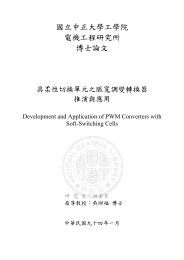Syntax of the Bi Comparative Construction in Mandarin Chinese
Syntax of the Bi Comparative Construction in Mandarin Chinese
Syntax of the Bi Comparative Construction in Mandarin Chinese
You also want an ePaper? Increase the reach of your titles
YUMPU automatically turns print PDFs into web optimized ePapers that Google loves.
<strong>Syntax</strong> <strong>of</strong> <strong>the</strong> <strong>Bi</strong> <strong>Comparative</strong> <strong>Construction</strong> <strong>in</strong> Mandar<strong>in</strong> Ch<strong>in</strong>ese<br />
(51) The Possible Syntactic Category <strong>of</strong> bi (Hs<strong>in</strong>g 2003: 62)<br />
bi as a<br />
conjunction<br />
bi as a<br />
preposition<br />
bi as a<br />
verb<br />
bi as a<br />
prepositional<br />
complementizer<br />
Advantage Disadvantages<br />
This answers that <strong>the</strong> two<br />
compared conjuncts are parallel<br />
<strong>in</strong> both semantics and syntax.<br />
It corresponds to than <strong>in</strong> English,<br />
which supports preverbal<br />
adjunction analysis<br />
This <strong>in</strong>dicates that <strong>the</strong> bi word<br />
has <strong>the</strong> mean<strong>in</strong>g <strong>of</strong> compar<strong>in</strong>g.<br />
30<br />
This fails to expla<strong>in</strong><br />
sentences<br />
pronouns.<br />
with reflexives<br />
It fails to expla<strong>in</strong> CC with<br />
preposition phrases.<br />
The syntactic behavior is<br />
different from real verb.<br />
The structure is simple. The morphology and<br />
syntactic structure lacks<br />
strong motivation.<br />
To get more clues, Hs<strong>in</strong>g make a list to compare <strong>Comparative</strong> Deletion and VP<br />
ellipsis.<br />
(52) Comparison between <strong>Comparative</strong> Deletion (CD) and VP Ellipsis<br />
(Hs<strong>in</strong>g 2003: 69)<br />
The properties <strong>of</strong> ellipsis VP Ellipsis Ch<strong>in</strong>ese CD<br />
(1) Occur <strong>in</strong> phrase-f<strong>in</strong>al position √ ? (subj del. &<br />
stripp<strong>in</strong>g<br />
temporal<br />
adverb)<br />
&<br />
(2) Operate on phrasal categories √ ? (stripp<strong>in</strong>g)<br />
(3) Occur <strong>in</strong> ei<strong>the</strong>r a subord<strong>in</strong>ate or coord<strong>in</strong>ate clause √ × (can be <strong>in</strong><br />
separate from that conta<strong>in</strong><strong>in</strong>g its antecedent<br />
ma<strong>in</strong> clause)<br />
(4) Obey <strong>the</strong> Backward Anaphora Constra<strong>in</strong>t √ √<br />
(5) Occur across sentence boundaries √ √<br />
(6) Able to have a pragmatic antecedent √ √<br />
(7) Strict/ sloppy ambiguity √ √<br />
(8) ECP: NON-pronom<strong>in</strong>al empty category must be<br />
properly head-governed<br />
√ ? (stripp<strong>in</strong>g)<br />
中正大學 e-Thesys (94 學年度)





